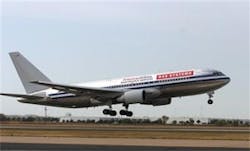FORT WORTH -- A prototype U.S. commercial airliner equipped with the military's laser-based technology as protection from terrorists armed with heat-seeking missiles took its first test flight at Alliance Airport on Thursday morning.
Just before noon, the American Airlines 767 passed several times over the airfield as engineers watched. Integrated into the plane's fuselage, near the tail, were electronic sensors that watched the ground for signs of missiles being fired. A laser emitter smaller than a dime and mounted on a small turret stood by, ready to rotate to a target and, if necessary, send out an invisible, infrared burst to disorient a missile's guidance system.
It's the newest attempt to shift U.S. military technology into the commercial sector, and the viability of such a system depends on whether scientists can make it fit seamlessly into the low-cost, high-turnaround world of passenger jets.
But if shoulder-fired missiles, called MANPADS for man-portable air defense systems, are proliferating quickly, as many security experts believe, it may be only a matter of time before threats demand such systems on all commercial jets.
"It's basically a sensing system and a jamming system," said Burt Keirstead, Counter-MANPADS program director for BAE Systems of Nashua, N.H., the company that has teamed with Fort Worth-based American Airlines to develop this prototype, which it calls Jeteye. "It will sense approaching missiles, shine a laser at the missiles and cause it to miss the aircraft."
Testing will continue through the end of the year.
BAE officials said they hoped to have certification from the Federal Aviation Administration by January.
The Department of Homeland Security has spent $233 million over three years pursuing a defense system to protect airliners against shoulder-fired missiles. Each Jeteye costs about $1 million. There is no rollout date yet, nor is there a federal funding mechanism, which would likely be necessary to make the program move from testing to installation.
"We're nowhere near that point yet," said John Hotard, spokesman for American Airlines Maintenance Services.
But Hotard said the economics of air transport cannot be divorced from security issues, and so the testing is going forward.
Homeland Security spokeswoman Valerie Smith said it is unlikely that the program would progress past the design and test stages unless there were credible evidence that shoulder-fired missiles posed a specific threat to U.S. air travel. That has not happened. If a threat were to occur, however, Smith said it would be likely that Homeland Security would prefer to have more than one manufacturer with a certified design to build.
To punctuate the 9-11 terrorist attacks, in late 2002, terrorists shot ground-to-air missiles at an Israeli airliner in Mombasa, Kenya, the first time the weapons had been used against commercial aircraft in a non-combat zone. The Defense Department has been trying to track the movement of Stinger missiles. National border security has been focused on stopping weapons from above from reaching U.S. shores. Calls for bolstering airport perimeter security in the wake of the 9-11 terrorist attacks increased once again.
Homeland Security initiated a two-year development and testing program and awarded contracts in January 2004. Of more than 100 proposals, two teams were selected by Homeland Security to develop prototype anti-shoulder missile systems. BAE Systems and American Airlines form one such team.
"American has been involved from the beginning in January '04," Keirstead said of the Jeteye program. "We couldn't have done this without them."
The other team is headed by Northrop Grumman. Its Guardian system, an offshoot of its Nemesis system used by the military, also uses lasers to disorient missile guidance systems and is at a similar phase of development. The main difference is that the BAE system is integrated into the plane's fuselage. The Northrop Grumman system is held underneath the fuselage.
Both the BAE and Northrop Grumman systems will be tested at Eglin Air Force base in Florida in the coming months, Smith said.
The European Union has also accelerated its missile-defense program.
One obvious advantage of putting a missile-defense system aboard a plane rather than at an airport is that the plane itself is the target. Its sensors can look directly down at an approaching missile. Because heat-seeking missiles' guidance systems "look up" at the heat signatures of their targets, ground-based defense systems must stop a missile that is headed away and not "looking" in the right direction, researchers said.
News stories provided by third parties are not edited by "Site Publication" staff. For suggestions and comments, please click the Contact link at the bottom of this page.






